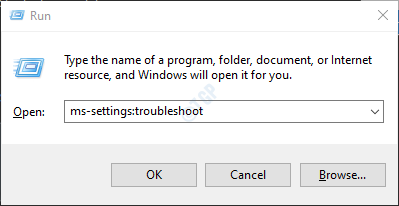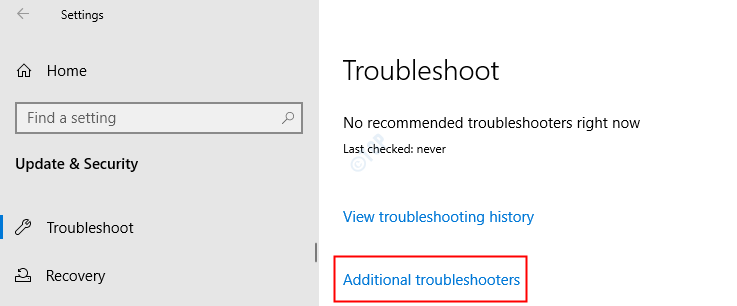Some of the Windows Users have reported that they encounter a Windows Update Error when while installing some updates in their system. This particular error with Error code 0x80070426 is seen both while updating the Windows and in the Microsoft Store while purchasing some apps.
Error Message in Windows Update –
There were problems installing some updates, but we’ll try again later. If you keep seeing this and want to search the web or contact support for information, this may help: (0x80070426)
Error Message in Microsoft Store –
Your purchase couldn’t be completed. Something happened and your purchase can’t be completed. Error code : 0x80070426
NOTE: There is an error related to Microsoft Essentials with the same error code. So, please double-check the error message before proceeding with the fixes.
In this article, we have curated some fixes that can help you solve this issue.
Fix 1: Reset Windows Store
Step 1: Open the Run Terminal using the keys Windows and R.
Step 2: Type cmd and hold the keys Ctrl+Shift+Enter to open the Command Prompt in Admin mode.
Step 3: If a confirmation dialog up asking for permission, just click on Yes.
Step 4: In the Command Prompt window that appears, type the below commands.
wsreset.exe
Step 5: Restart your system.
Check if this helps. If not, try the next fix.
Fix 2: Run Windows Update Troubleshooter
Step 1: Open the Run Dialog.
Step 2: In the appearing window, type the command ms-settings:troubleshoot and click on OK.

In Windows 10
Step 3: In the Settings–> Update & Security –> Troubleshoot window that appears, choose the Additional troubleshooters option

Step 4: In the Additional Troubleshooters window that opens, choose the Windows Update option
Step 5: Click on then Run the troubleshooter button
Step 6: Now, the system will start looking for problems. You will be notified once the problem is found, follow the on-screen instructions to fix the problem.
Step 7: Restart the System.
In Windows 11:
Step 3: In the appearing window, click on Troubleshoot.
Step 4: Now, click on Other Troubleshooters.
Step 5: Click on the Run button next to Windows Update.
Step 6: Now, the system will start looking for problems. You will be notified once the problem is found, follow the on-screen instructions to fix the problem.
Step 7: Restart the System.
Check if this helps. If not try the next fix.
Fix 3: Reset Windows Update Components
Step 1: Open the Run Terminal using Windows and R.
Step 2: Type cmd and hold the keys Ctrl+Shift+Enter to open the Command Prompt in Admin mode.
Step 3: If a confirmation dialog up asking for permission, just click on Yes.
Step 4: In the Command Prompt window that appears, type the below commands. Make sure to hit enter after every command.
net stop wuauserv net stop cryptSvc net stop bits net stop msiserver ren C:\Windows\SoftwareDistrubution SoftwareDistribution.old ren C:\Windows\System32\catroot2 Catroot2.old net start wuauserv net start cryptSvc net start bits net start msiserver exit
Step 5: Open Run Dialog again.
Step 6: Type powershell and press Enter.
Step 7: If you see a confirmation dialog popping up, click on Yes.
Step 8: In the window that opens, copy-paste the following commands. Make sure to hit Enter after every command.
wuauclt.exe /updatenow exit
Step 5: Restart the system.
Fix 4: Perform a DISM and SFC Scan
Step 1: Open Run Dialog. Use the shortcut Window and R.
Step 2: In the Dialog, type cmd and press Ctrl+Shift+Enter. This opens Command Prompt in Admin Mode.
Step 3: In the command prompt window that opens, Enter the following commands. Please don’t forget to hit Enter after each command.
Dism /Online /Cleanup-Image /CheckHealth Dism /Online /Cleanup-Image /ScanHealth Dism /Online /Cleanup-Image /RestoreHealth sfc /scannow
Step 4: Restart your system.
Check if this helps, if not, try the next fix.
Fix 5: Enable the Microsoft Account Sign-in Assistant
Step 1: Open the Run Dialog using Windows+R.
Step 2: Type the command powershell and hold the keys Ctrl+Shift+Enter to open PowerShell with Admin rights.
Step 3: If you see a UAC prompt, click on Yes.
Step 4: In the PowerShell window that opens, enter the below command to check the status of Microsoft Account Sign-in Assistant Service.
Get-Service -DisplayName "Microsoft Account Sign-in Assistant"
Step 5: If you see the status as stopped, enter the below command to start the service.
Start-service -DisplayName "Microsoft Account Sign-in Assistant"
Step 6: You can check the status to confirm that it has started.
Fix 6: Disable the Third-party Firewall temporarily
If you have any third-party antivirus installed in the system, temporarily disabling it or uninstalling the AV might help. Note that the issue is not known to be caused by Windows Defender Firewall. It is usually seen with AVs like Mcafee, Avast, Combo, etc.
Step 1: Firstly, try disabling the antivirus program. Refer to the AV website to see how to disable the antivirus as the instructions are different for every vendor.
Step 2: If disabling did not work, then try uninstalling the AV program altogether.
Step 3: Open the Run window using Windows+R
Step 4: Type appwiz.cpl and hit Enter.
Step 5: In the Program and Features window that opens, locate your Antivirus software.
Step 6: Right-click on the software and choose Uninstall as shown below.
Step 7: Follow the onscreen instructions and complete the uninstallation process.
Step 8: Restart the computer.
Step 9: Try performing the backup again.
Step 10: If you don’t find any error messages, this means that the third-party antivirus caused the issue.
Step 11: Try installing the third-party antivirus software again with the latest version and check if you see the issues.
Step 12: If you are still seeing the issue, you might have to wait till the next version is released.
Fix 7: Download the Update Manually
Step 1: Open the Run Dialog using the keys Windows and R
Step 2: Type the below command and hit Enter.
ms-settings:windowsupdate-history
Step 3: In the appearing window, locate the update that has failed and identify its KB number. Refer to the screenshot below.
NOTE: The below image is just for demonstration.
Step 4: Open the Microsoft Update Catalog
Step 5: Choose the update based on your build and click on the Download button as shown below.
Step 6: Try Installing the update now.
That’s All.
We hope this article has been informative. Thank you for Reading.
Kindly comment and let us know the fix that has helped you solve the problem.
